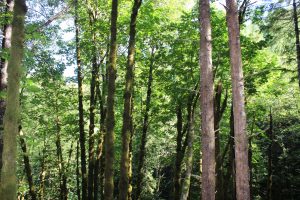HJA 1
At the HJ Andrews Forest, I expect to observe an ecosystem that’s been alive and developing much longer than I or anyone I know has been, and will survive long beyond everyone living has passed. I expect to see a lot of really, really tall trees and the small creatures that call those trees home. There are as many ways of telling the story of these forests as there are people to experience it. Some choose a scientific lens, asking questions that can be answered and then collecting data to do so. Others ask unanswerable questions, exploring the forest through poetry or creative writing. Science gives the world of creative reflection more material to analyze with every experiment carried out, and creative writing may prompt science with never before asked questions. In both realms it is important to understand to have a long-range focus. Humans seek interaction with unspoiled nature, but in doing so often spoil it. We need to look to future so that we can prepare for it, and look to the past to know how to do or not do so.
HJA 2
Research and Revelation was chosen because scientific inquiry is permeates most of the permanent ongoings of those who work at the forest, as it is such a great scientific resource in the study of old growth forests and their ecosystems. Before addressing the forest poetically, it is important to have an understanding of the physical makeup of your surroundings. After reading this section, when I picture the forest in my head I see green everywhere I look and many, many trees taller than any I have seen before surrounding huge lakes. I also see decaying logs. In the ground work essay, the author emphasizes the ongoing change in the forest, whether it be by the season, year, or century. The excerpt The Web captures this change with vocabulary such as “beauty moves,” “snowmelt sieving through fungal mats,” “tunneling,” and “fluming” (21). A question I have about the forest is if there is any portion of it that is unmapped or unexplored.
HJA 3
Change and Continuity is an applicable concept to explore because the HJ Andrews is a dynamic ecosystem that is constantly developing, but never strays far from its roots. It reminds readers and researchers alike that no matter how long you have been studying the forest there will always be something new for you to observe or interpret. After reading this section I’ve added some large open fields into my landscape of tall trees, and I also image a lot of fog that sets the mood for contemplation. The Ground Work essays introduce the idea of humans as being instruments of change in the forest instead of just observers. An example of this is purposefully setting forest fires and then observing the results. In Clear Cut by John Maloof, he explores the negative side of this human – forest interaction, criticizing the “men in machines” who have “given us sun” but given left the woodpecker with no place to land (149). This section left me with the question of how close people live to the forest.
HJA 4
The section Borrowing Each Other’s Eyes is applicable because both the scientific research and creative inquiry carried out at the forest builds upon and is enriched by work that has been done by others. After reading this section a lot more bodies of water have entered into the landscape in my mind – rivers, streams, etc. The groundwork essay emphasizes this prevalence of water in the forest and this importance is echoed in “Parsing my Wise as Lookout Creek,” which simply by the title equates someone’s wife with a creek. The author’s wife is as important to and intertwined with him as the creek is to the forest. I am curious as to what the biggest body of water in the forest is.
Monica Stack



I really enjoyed reading your reflection. I was particularly elated by the enthusiasm that you had of seeing in the field an ecosystem that was thriving, and that will continue to exist into the distant future. This in tandem with the long term view that the author of ‘Forest under Study’ encourages us to adopt by having faith in the future of our ecosystems. Additionally, I like your accentuation of the inter-dependence between science and creative writing in telling stories and asking relevant thought-provoking questions about our ecosystems. This I believe is very invaluable in guiding our perceptions and engagement with our systems.